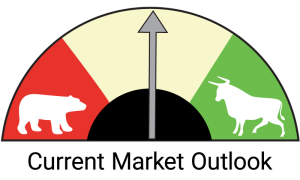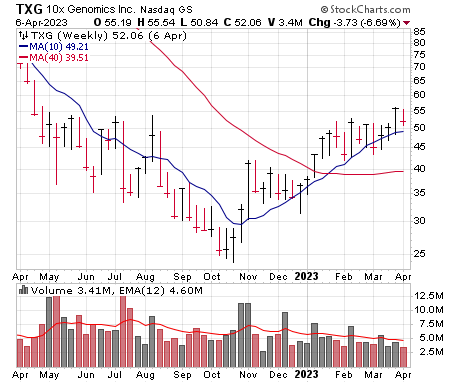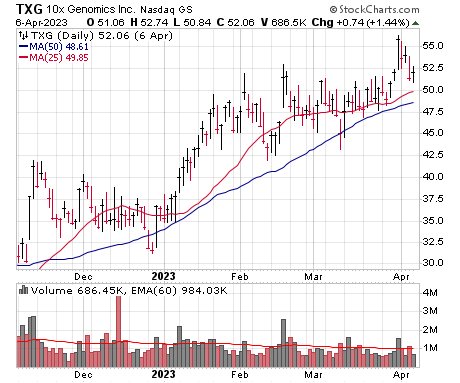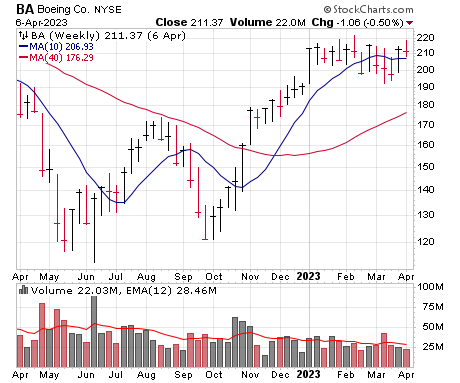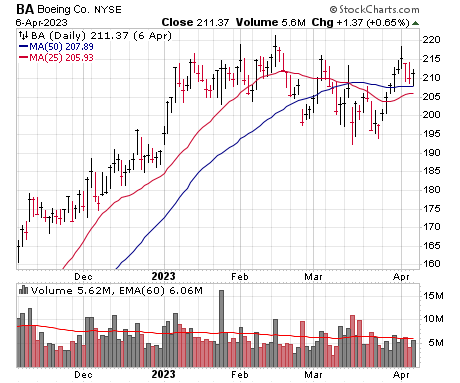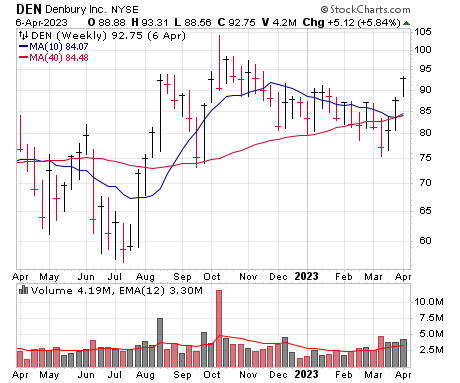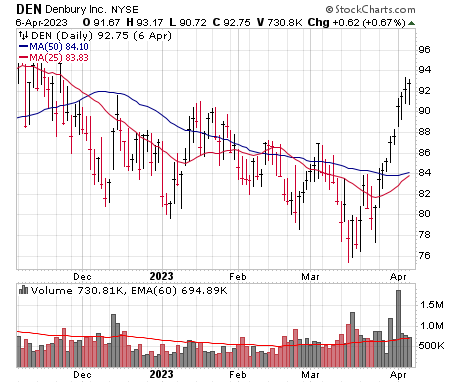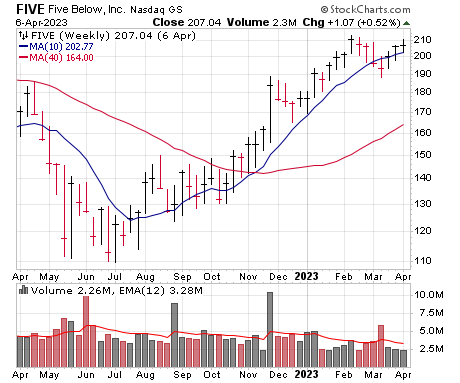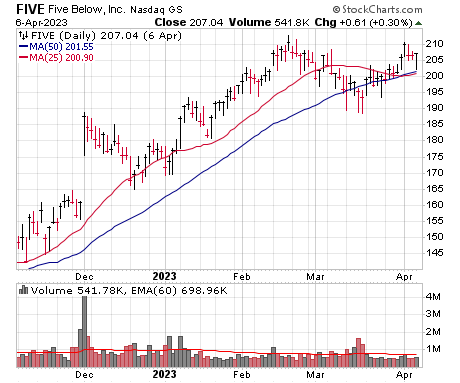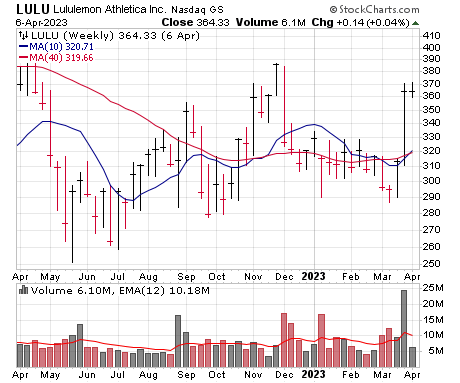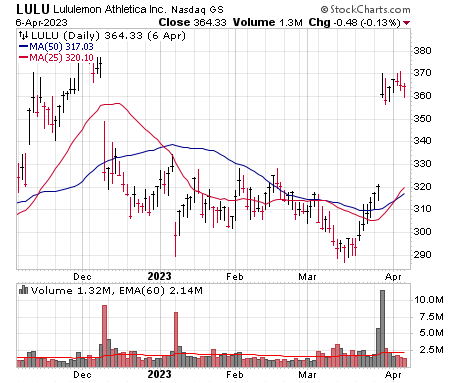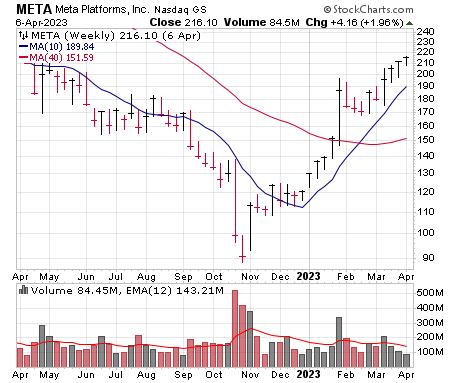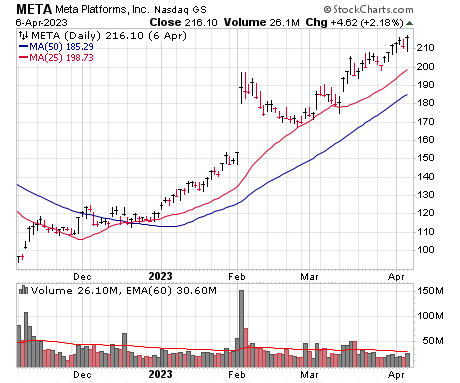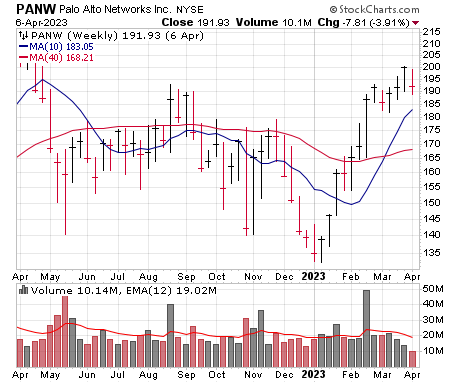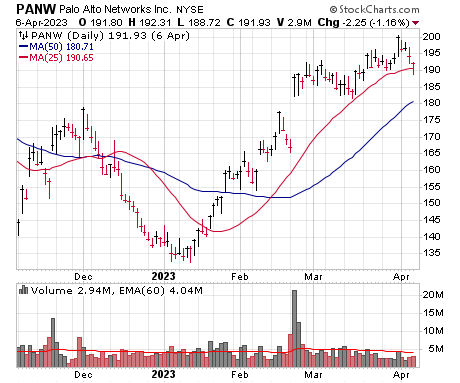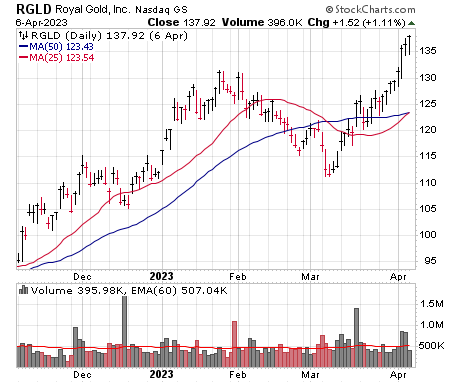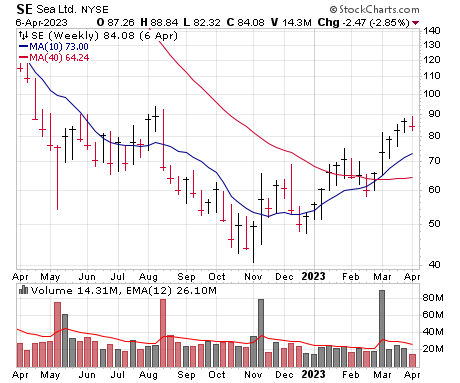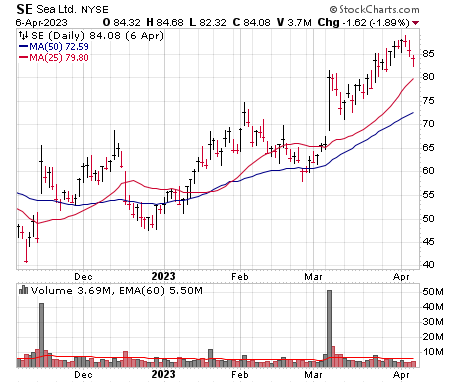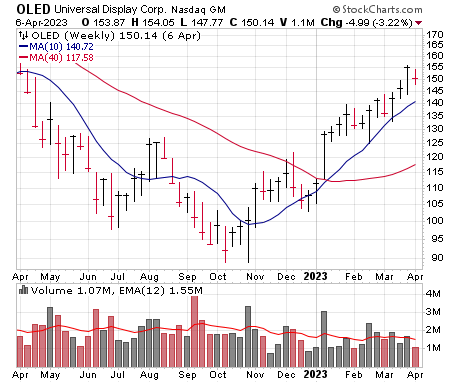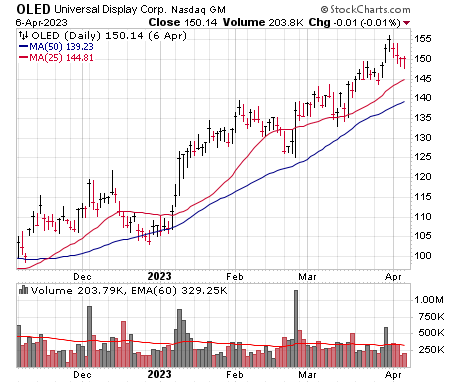More Washing Machine-Type Action
After a couple of good weeks, some pullback was half-expected—and, when looking at the big-cap indexes, nothing out of the ordinary has been seen. That said, digging deeper, we saw a good amount of selling in resilient stocks (mostly growth names last week), another round of selling in the broad market (small- and mid-caps, etc.) all while defensive names (consumer staples, big-cap healthcare) found buyers. To this point, the potential leaders that took on water are still holding onto intermediate-term support, and given that we’re far from flooring the accelerator, we’re not advising any major change in stance at this point. That said, the next couple of weeks will be key (for good or bad), especially as earnings season gets started. We’ll leave our Market Monitor at a level 5 today.
This week’s list has an interesting mix of names, including more than a few turnaround-type actors that remain under accumulation. Our Top Pick is Five Below (FIVE), which offers a mix of growth and defensiveness in this environment. Shares actually moved to multi-month highs today.
| 10x Genomics (TXG) |
| Boeing (BA) |
| Denbury (DEN) |
| Five Below (FIVE) ★ Top Pick ★ |
| Lululemon (LULU) |
| Meta Platforms (META) |
| Palo Alto Networks (PANW) |
| Royal Gold (RGLD) |
| Sea Ltd (SE) |
| Universal Display (OLED) |
Stock 1
10x Genomics (TXG)
Price | Buy Range | Loss Limit |
Why the Strength
10x Genomics is a technology provider to biomedical researchers focused on human cells. The business is built on the premise that the next phase of genomics is moving beyond mapping and sequencing DNA to focus on both smaller biological forms (exploring the millions of molecules and their interactions within a cell) as well as larger ones (the complex interaction of many cells to form tissues and organs). To 10x, the genomics industry has largely compiled the “parts list” of human biology, and now the industry is moving to understand how those parts fit together … and how to manipulate them for better health (and profit). The company develops and sells highly sophisticated instruments and software and well as consumable products used in research for this next phase. Consumables were 85% of 10x’s revenue of $516 million last year, with a smaller, $73 million, slice of sales in instruments important for driving future growth of consumables. After years of hearty double-digit sales growth, 10x Genomics revenue ticked up only 5% last year, largely due to a shutdown-related cut of orders from China as well as some product cannibalization, as newer, higher-margin instruments ate away at the market share of older, less profitable ones. That said, a re-acceleration is likely at hand, with growth seen rebounding into the 20% range both this year and next. That will get revenue close to $600 million in 2023 even with China still weak (potential upside if orders there start to pick up). What 10x does requires a lot of research and development expenses – that’s good in one sense because it disheartens competitors, giving the business a competitive moat. But it’s obviously negative as 10x burns plenty of cash, though analysts see the bottom line getting into the black next year, and cash flow positive by year-end 2023. 10x has always had a good story, and it appears to be leaving a tough stretch in the rearview mirror.
Technical Analysis
TXG topped near 200 over many months in 2021 and then a fundamental slowdown, a high valuation and the bear market sent the stock to the glue factory, falling to 24 near Halloween of last year with very few rally attempts along the way. However, TXG has changed character since then, with a quick pop into November, a rally into the low 50s after the calendar flipped and then a poke to new highs two weeks ago. If you want in, we’re OK nibbling on last week’s dip with a stop in the mid-40s
| Market Cap | $6.00B | EPS $ Annual (Dec) | ||
| Forward P/E | N/A | FY 2021 | -0.53 | |
| Current P/E | N/A | FY 2022 | -1.46 | |
| Annual Revenue | $517M | FY 2023e | -1.25 | |
| Profit Margin | N/A | FY 2024e | -0.65 | |
| Qtrly Rev | Qtrly Rev Growth | Qtrly EPS | Qtrly EPS Growth | |
| ($M) | (vs. yr-ago-qtr) | ($) | (vs. yr-ago-qtr) | |
| Latest qtr | 156 | 9% | -0.15 | N/A |
| One qtr ago | 131 | 5% | -0.37 | N/A |
| Two qtrs ago | 115 | -1% | -0.57 | N/A |
| Three qtrs ago | 115 | 8% | -0.38 | N/A |
Weekly Chart | Daily Chart |
Stock 2
Boeing (BA)
Price | Buy Range | Loss Limit |
Why the Strength
Like successful retail stories (such as Five Below and Lululemon, written about later in this issue), aerospace cycles usually last for many years, and mega-cap Boeing—the granddaddy of the industry—is at the front-edge of a new growth phase that is producing huge cash flow and (eventually) earnings. The company obviously needs no introduction, as it’s one of the two big aircraft makers in the world, and after a rough couple of pandemic-affected years (lower demand and some supply chain issues), orders and backlog are piling up and execution is improving, which should lead to some impressive results going ahead. Last year, Boeing delivered 480 planes (up 41% from 2021), with Q4’s deliveries accelerating (up 54% from the year-ago quarter), all of which is to the good—but even those figures were still below new orders (376 planes in Q4 alone) and a drop in the bucket compared to the overall backlog (more than 4,500 planes valued at $330 billion). And 2023 remains on track for even better times—the top brass still expects to ship about 425 737s this year, and after a short pause, deliveries of the 787 are back on (target of 75 shipped this year), with the 767 chipping in starting this quarter (there’s been an issue with the center fuel tank that’s being fixed), all while orders continue to flood Boeing’s book (orders for more than 300 planes announced since late January, not including options to purchase dozens more from a variety of clients). All in all, while Wall Street sees flat-ish earnings, Boeing sees free cash flow of around $4 billion ($6.75 per share), and it thinks that figure can rise to $10 billion over time as production levels and lingering supply chain issues improve. There’s no dividend or share buyback going now, but that could change and be another catalyst in the months ahead. The Q1 report is due April 26.
Technical Analysis
BA peaked near 450 in 2019, hit a post-pandemic peak near 280 in March 2021 and fell to the 115 to 120 area a couple of times last year as the bear did its work. However, the rally from October through early January was very impressive and persistent, and while the stock has been capped since then, the pullback’s been very mild—and the recent rally put BA back near the top of its consolidation. We’re intrigued: If you want in, you can start small here and consider adding on any powerful breakout.
| Market Cap | $126B | EPS $ Annual (Dec) | ||
| Forward P/E | N/M | FY 2021 | -9.43 | |
| Current P/E | N/A | FY 2022 | -11.06 | |
| Annual Revenue | $66.7B | FY 2023e | 0.07 | |
| Profit Margin | N/A | FY 2024e | 5.55 | |
| Qtrly Rev | Qtrly Rev Growth | Qtrly EPS | Qtrly EPS Growth | |
| ($B) | (vs. yr-ago-qtr) | ($) | (vs. yr-ago-qtr) | |
| Latest qtr | 20.0 | 35% | -1.75 | N/A |
| One qtr ago | 16.0 | 4% | -6.18 | N/A |
| Two qtrs ago | 16.7 | -2% | -0.37 | N/A |
| Three qtrs ago | 14.0 | -8% | -2.75 | N/A |
Weekly Chart | Daily Chart |
Stock 3
Denbury (DEN)
Price | Buy Range | Loss Limit |
Why the Strength
Denbury is a U.S. oil and gas producer specializing in enhanced oil recovery (EOR), which is a method of injecting CO2 into fields to extract fossil fuels that are otherwise unattainable. The recent rise in oil prices helps Denbury like any producer, but the twist here is that 29% of oil extracted by Denbury’s CO2 method last year sequestered much more carbon than the oil will emit, allowing the company to earn carbon capture utilization and storage (CCUS) credits. The bulk of Denbury’s business right now is still centered around producing traditional oil, accounting for the lion’s share of last year’s $1.6 billion sales, while just $61 million came directly from carbon transport and sequestering sales. But blue oil, as carbon-negative oil production is termed, is a fast-growing business for Denbury and should pay off huge in the years ahead; the firm says it doubled its 2022 goals in the segment by signing deals for 20 million tons of carbon transportation through its pipelines, as well as for carbon sequestration. Denbury’s growth is seen coming from a new Rocky Mountain field ramping up this year, the Cedar Creek Anticline (CCA) in Montana and North Dakota. The company says CCA has about 400 million recoverable barrels, out of an estimated five billion in the rock. Denbury began injecting CO2 into the field late last year and expects it to start forcing out oil in the back half of 2023. That’ll really benefit 2024 as production hits full stride and CCUS credits – which can be sold – pile up. In the meantime, the business is profitable and management tends to like stock buybacks to reward shareholders. If oil averages $75 a barrel, look for $1.4 billion in sales and EPS over $6, with those figures rising nicely if oil does the same. It’s an interesting old- and new-world energy play.
Technical Analysis
After a massive 2020/2021 advance, DEN bumped downhill into the summer of last year, falling nearly 40% from high to low. Interestingly, shares ramped quickly back to their highs in the summer and again in October before suffering another downturn. That said, the past few months saw DEN act much more under control even as it slid, and now we’ve seen three straight weeks of above-average volume buying. We’re OK nibbling here or (preferably) on dips with a stop in the low 80s.
| Market Cap | $4.62B | EPS $ Annual (Dec) | ||
| Forward P/E | 16 | FY 2021 | 2.56 | |
| Current P/E | 14 | FY 2022 | 6.78 | |
| Annual Revenue | $1.72B | FY 2023e | 5.95 | |
| Profit Margin | 21.0% | FY 2024e | 6.38 | |
| Qtrly Rev | Qtrly Rev Growth | Qtrly EPS | Qtrly EPS Growth | |
| ($M) | (vs. yr-ago-qtr) | ($) | (vs. yr-ago-qtr) | |
| Latest qtr | 381 | 5% | 1.48 | 95% |
| One qtr ago | 440 | 28% | 1.90 | 157% |
| Two qtrs ago | 482 | 60% | 1.69 | 177% |
| Three qtrs ago | 412 | 64% | 1.69 | 284% |
Weekly Chart | Daily Chart |
Stock 4
Five Below (FIVE) ★ Top Pick ★
Price | Buy Range | Loss Limit |
Why the Strength
Institutional investors are always looking for rapid and reliable growth, and that’s especially true today as fears increase that the economy is headed over the falls. Five Below might be the best “defensive growth” story out there: Its effectively a higher-priced dollar store (mostly $5 and below items for teens and pre-teens in a variety of categories, though it’s increasingly testing prices up to $10 with its “Five Beyond” concept) and shouldn’t be impacted much by a general slowdown in consumer spending, yet the firm’s growth outlook is excellent, thanks to a best-in-class cookie-cutter story—which itself is bolstered by best-in-class store economics, where new stores pay back the initial investment in less than a year! The firm ended January with 1,340 stores, but that count usually rises 10%-plus each year (it aims to open 200 new locations this year and grow the store base by 15% to 20% annually through 2025) and the top brass thinks there’s potential for 3,500 locations down the road. And, as an added bonus, Five Below is just coming out of a stretch of higher investments (distribution facilities) and some cost issues (supply chain, etc.), and now it looks like things are turning up—in the all-important holiday quarter, sales and earnings topped expectations while same-store sales rose 1.9%, and management released a solid 2023 guide, with same-store sales up 1% to 4% while analysts see earnings back on the low 20% growth path that existed prior to the pandemic. It’s not as young as it used to be, but Five Below should still have years of expansion ahead.
Technical Analysis
FIVE has enjoyed an excellent rebound from its lows last summer, with the Q3 earnings pop (around Thanksgiving) helping the cause. Shares rallied all the way into the 212 range, bringing it back near all-time highs (around 230 from late 2021), and during the past seven weeks, we’ve seen a calm, reasonable rest period as the stock digests its gains. Shares actually lifted to multi-month highs today, so we’re OK nibbling here, though we’re also open to buying on any near-term dip, too.
| Market Cap | $11.5B | EPS $ Annual (Jan) | ||
| Forward P/E | 37 | FY 2022 | 4.90 | |
| Current P/E | 44 | FY 2023 | 4.68 | |
| Annual Revenue | $3.08B | FY 2024e | 5.62 | |
| Profit Margin | 15.2% | FY 2025e | 6.86 | |
| Qtrly Rev | Qtrly Rev Growth | Qtrly EPS | Qtrly EPS Growth | |
| ($M) | (vs. yr-ago-qtr) | ($) | (vs. yr-ago-qtr) | |
| Latest qtr | 1123 | 13% | 3.06 | 23% |
| One qtr ago | 645 | 6% | 0.29 | -33% |
| Two qtrs ago | 669 | 3% | 0.74 | -35% |
| Three qtrs ago | 640 | 7% | 0.59 | -30% |
Weekly Chart | Daily Chart |
Stock 5
Lululemon (LULU)
Price | Buy Range | Loss Limit |
Why the Strength
Lululemon isn’t a new name, of course—it practically invented the athleisure industry many years ago and its higher-priced wares are in high demand—and the stock hasn’t gone anywhere (on a net-net basis) since late 2020. However, fundamentally, business has remained strong, and big investors are thinking there are plenty of expansion opportunities left in the tank. In Q4, sales (up 30%) and earnings (up 31%) were a bit above expectations, and just as impressive is that all segments are looking strong; on a three-year basis, both men’s (up 26%) and women’s (up 23%) products are growing handily, while accessories (up 44%), e-commerce (up 46%) and North America (up 24%) and international (up 39%) all contributed in a big way. (Lululemon gained 2.3 percentage points of market share in Q4, the most of any apparel brand.) The greater the breadth of products selling well, the more sustainable things are—indeed, management launched a new three-year plan last year, aiming for 15% annual revenue growth and faster earnings growth as margins expand, but that will probably prove conservative as new products are released (including a road-to-trail shoe and updates/expansion to many existing offerings), some geographies (especially China) kick into gear post-lockdown and as the firm’s store expansion plan continues to clip along (655 stores at the end of January, up 14% from a year ago; 47 new openings and 25 remodels in 2023, including a couple dozen or so new openings in China). A modest share buyback program ($700-plus million left on the authorization) puts a cherry on top of this still-great retail story.
Technical Analysis
LULU topped at 485 in November 2021 and fell as low as 250-ish last May, but despite that being the bottom, shares never really gained much steam, and the early-December earnings report brought a big gap down. Interestingly, though, LULU mostly held support around 300 after that and, following a mini-shakeout during the bank panic, soared on earnings two weeks ago and held up great even as most growth names got hit last week. We’ll set our buy range down a bit from here.
| Market Cap | $44.5B | EPS $ Annual (Jan) | ||
| Forward P/E | 27 | FY 2022 | 7.79 | |
| Current P/E | 36 | FY 2023 | 10.07 | |
| Annual Revenue | $8.11B | FY 2024e | 11.61 | |
| Profit Margin | 20.3% | FY 2025e | 13.44 | |
| Qtrly Rev | Qtrly Rev Growth | Qtrly EPS | Qtrly EPS Growth | |
| ($B) | (vs. yr-ago-qtr) | ($) | (vs. yr-ago-qtr) | |
| Latest qtr | 2.77 | 30% | 4.40 | 31% |
| One qtr ago | 1.86 | 28% | 2.00 | 23% |
| Two qtrs ago | 1.87 | 29% | 2.20 | 33% |
| Three qtrs ago | 1.61 | 32% | 1.48 | 28% |
Weekly Chart | Daily Chart |
Stock 6
Meta Platforms (META)
Price | Buy Range | Loss Limit |
Why the Strength
A slowdown in digital advertising, along with Apple’s privacy features that limit iPhone user tracking, resulted in lower revenue last year for Meta. The Apple development in particular was a big blow to Meta (covered in the March 13 issue), since the company relies heavily on ad tracking, with 98% of total sales comprised of mobile ads. According to one industry report, Apple’s privacy changes have cut the average mobile advertiser’s return on investment by 40% while reducing mobile ad spend by 25%, a development Meta obviously sees as a significant headwind—and when combined with its big increase in CapEx, led to earnings falling by a lot. However, the company is now responding in a few ways. First came some major cost-cutting measures, including the reduction of headcount by 21,000 since November. The aggressive cuts prompted several Wall Street institutions to raise share price targets for Meta based on improving efficiencies and a better profitability outlook for 2023. Additionally, efforts by lawmakers to ban one of Meta’s key competitors, TikTok, for U.S. users could further improve Meta’s growth outlook, and the firm’s recent rollout of advertisements for search results on its popular Instagram photo and video sharing platform is another plus. (Instagram may already be benefiting from the proposed TikTok ban as that platform’s minutes used per day have spiked of late). As part of the firm’s touted “Year of Efficiency,” Meta has introduced an authentication service to protect users from online identity theft; has rolled out a paid subscription service for Facebook and Instagram that awards a badge for user verification aimed at stopping impersonators’ attempts to scam customers; and is further ramping investments in artificial intelligence (AI) in order to tailor ads for users. All told, analysts expect the strategy to pay off with sales starting to pick up in Q2 and with earnings gradually accelerating for the next several quarters. Earnings are due April 26.
Technical Analysis
We missed our entry point on META last month, with the stock refusing to pull back much … and it’s continued to trend higher even in the face of the market’s March dip and the recent growth stock pullback. That’s obviously a sign of strength, which keeps us interested, at the right price anyway—we’re still not of a mind to chase here, thinking a shakeout (possibly back toward the 200 level) is possible ahead of earnings.
| Market Cap | $560B | EPS $ Annual (Dec) | ||
| Forward P/E | 22 | FY 2021 | 13.77 | |
| Current P/E | 25 | FY 2022 | 8.59 | |
| Annual Revenue | $117B | FY 2023e | 9.82 | |
| Profit Margin | 14.5% | FY 2024e | 12.21 | |
| Qtrly Rev | Qtrly Rev Growth | Qtrly EPS | Qtrly EPS Growth | |
| ($B) | (vs. yr-ago-qtr) | ($) | (vs. yr-ago-qtr) | |
| Latest qtr | 32.2 | -4% | 1.76 | -52% |
| One qtr ago | 27.7 | -4% | 1.64 | -49% |
| Two qtrs ago | 28.8 | -1% | 2.46 | -32% |
| Three qtrs ago | 27.9 | 7% | 2.72 | -18% |
Weekly Chart | Daily Chart |
Stock 7
Palo Alto Networks (PANW)
Price | Buy Range | Loss Limit |
Why the Strength
With the accelerating growth in online business and mobile work comes the increased risk of cyberattacks, making cybersecurity a top priority for individuals and enterprises alike. The latter category has been the growth driver for Palo Alto (covered in the February 27 issue), a leading player in the cybersecurity space with a recent focus on providing security solutions for hybrid cloud and remote workforces. Over the last 10 quarters, Palo’s year-on-year revenue growth hasn’t fallen under 20%, and much of this growth is driven by high-value transactions (in the latest quarter the number of $10 million-plus deals soared a whopping 144%!). What’s more, even as companies tighten their budgets in the face of economic uncertainty, investment in cybersecurity continues to increase, with Palo garnering more than its fair share of this huge market. A big opportunity for Palo Alto going forward is the increased use of Zero Trust Network Access (ZTNA) over virtual private networks (VPN), mainly due to performance issues with the latter. Indeed, more organizations are embracing ZTNA, which combines continuous trust verification and deep, ongoing security inspection to protect all users, devices, apps and data, and this network design approach is expected to reach 70% of remote access deployments by 2025 (versus just 10% in 2021). Prisma Access is Palo’s solution for ZTNA for remote workers and a big reason why Palo has added more than 4,000 clients in this field in the last six quarters, with bookings exceeding $1 billion. Wall Street is sold on the growth story and sees solid revenue and cash flow growth ahead.
Technical Analysis
PANW hasn’t done much since we wrote about it in late February—and that’s a good thing given the banking crisis and the renewed growth stock wobbles last week. Overall, shares have held onto the vast majority of their sharp January-February upmove, and even after the stock’s low-volume dip late last week, PANW is holding onto its 25-day line. We think a small buy around here and a stop in the mid-170s is a decent risk/reward situation.
| Market Cap | $58.1B | EPS $ Annual (Jul) | ||
| Forward P/E | 48 | FY 2021 | 2.05 | |
| Current P/E | 59 | FY 2022 | 2.52 | |
| Annual Revenue | $6.16B | FY 2023e | 4.02 | |
| Profit Margin | 20.0% | FY 2024e | 4.68 | |
| Qtrly Rev | Qtrly Rev Growth | Qtrly EPS | Qtrly EPS Growth | |
| ($B) | (vs. yr-ago-qtr) | ($) | (vs. yr-ago-qtr) | |
| Latest qtr | 1.66 | 26% | 1.05 | 81% |
| One qtr ago | 1.56 | 25% | 0.83 | 51% |
| Two qtrs ago | 1.55 | 27% | 0.80 | 51% |
| Three qtrs ago | 1.39 | 29% | 0.60 | 30% |
Weekly Chart | Daily Chart |
Stock 8
Royal Gold (RGLD)
Price | Buy Range | Loss Limit |
Why the Strength
Gold prices are nearing a record high after rising 25% from their November lows, buoyed by a weaker dollar, lower bond yields and worries about the health of the U.S. (and global) banking sector. Consequently, investors are looking closer at mining firms that tend to outperform when the yellow metal price is strengthening, and Royal Gold is one of them. The company has always had one of the better stories in the sector: Royal is a streamer, which means it doesn’t engage in physical mining but provides up-front payments to miners in exchange for the right to buy gold, silver, copper and other resources at a set price (or else receive a percentage of the metals’ sales), providing Royal with consistently big margins (36.6% after tax in Q4) and an advantage over CapEx-heavy peers. Royal’s strategy of adding high-quality assets to its portfolio and focusing on liquidity and capital returns to shareholders is a long-term positive, though prices for gold and other metals still drive results: In Q4, revenue of $163 million was off 3% from a year ago (73% of sales involved gold, 12% copper and 11% silver), though cash flow increased 70% and per-share earnings of 91 cents beat estimates by 14%. On the production front, total volume of 335,100 gold equivalent ounces was above the midpoint of Royal’s prior guidance range, prompting management to increase the dividend for the 22nd consecutive year (albeit a modest 1.1% yield), achieving S&P High-Yield Dividend Aristocrat status. During 2022, Royal also acquired two world-class royalties in Nevada and a royalty in an emerging project in Canada and increased stream rates for two of its major properties. Management expects margins to remain strong this year despite higher costs for most producers, while Wall Street sees revenue jumping 10% and earnings nose out to a new all-time high.
Technical Analysis
After soaring almost 50% in last year’s Q1, RGLD was hit hard by the plunge in the physical metal for the seven months that followed. By the time the nadir was seen in early November, the stock had fallen 40% from its peak, but a character change was seen immediately afterward, and by late January, RGLD was back over 130. The next pullback was far more calm, with shares holding well above their 40-week line—and now shares are out to new recovery highs on solid volume. Minor weakness would be tempting.
| Market Cap | $9.05B | EPS $ Annual (Dec) | ||
| Forward P/E | 35 | FY 2021 | 4.00 | |
| Current P/E | 40 | FY 2022 | 3.43 | |
| Annual Revenue | $602M | FY 2023e | 3.90 | |
| Profit Margin | 36.6% | FY 2024e | 4.12 | |
| Qtrly Rev | Qtrly Rev Growth | Qtrly EPS | Qtrly EPS Growth | |
| ($M) | (vs. yr-ago-qtr) | ($) | (vs. yr-ago-qtr) | |
| Latest qtr | 163 | -3% | 0.91 | -13% |
| One qtr ago | 131 | -25% | 0.71 | -34% |
| Two qtrs ago | 146 | -13% | 0.81 | -22% |
| Three qtrs ago | 162 | 14% | 0.99 | 18% |
Weekly Chart | Daily Chart |
Stock 9
Sea Ltd (SE)
Price | Buy Range | Loss Limit |
Why the Strength
Singapore-based Sea Ltd. is one of Southeast Asia’s and South America’s leading e-commerce, online entertainment and financial service providers. Its e-commerce (Shopee) and online game and social (Garena) segments have been compared to Amazon and Activision, while its digital payments arm, SeaMoney, offers e-wallet services, payment processing and other financial products. A blowout Q4 report and a turn toward profitability are the reasons for the strength, with total sales of $3.5 billion increasing 7% from a year ago and beating estimates by 13%. More importantly, earnings per share of 66 cents, meanwhile, obliterated expectations and allowed the company to turn a profit for the first time. By segment, Shopee brought in the lion’s share of revenue for Sea in Q4, garnering sales of over $2 billion (up 32%), and SeaMoney also saw solid growth (up 92%), though that’s a small piece of the pie; Garena’s nearly $1 billion in sales were down from a year ago, as were bookings in that segment. Even so, the focus remains mostly on Shopee and the bottom line’s move into the black: One major institution raised its outlook for the company on the basis of improved take rates (percentage of the gross merchandise volume the platform gets to keep) for Shopee, and management is pointing toward e-commerce and e-wallet being the real drivers going ahead. Sea also believes “highly favorable” demographic trends and relatively low e-commerce penetration in the markets it serves point to lots more opportunity ahead. While the top line is expected to grow modestly (though re-accelerate later this year), earnings are seen rising sharply, and odds favor current estimates will prove low.
Technical Analysis
SE was one of the biggest winners from 2019 through 2021, but the hangover was fierce, with shares falling from a summit near 350 to a low of 40 last fall. A positive reaction to Q3 earnings stopped the decline, and while it’s been up and down, SE has etched higher highs and lows since then—with the Q4 report a month ago kicking off a move to multi-month highs. The dip of late looks normal; if you want in, we’re OK nibbling here.
| Market Cap | $43.4B | EPS $ Annual (Dec) | ||
| Forward P/E | 49 | FY 2021 | -2.96 | |
| Current P/E | N/A | FY 2022 | -1.84 | |
| Annual Revenue | $12.5B | FY 2023e | 1.72 | |
| Profit Margin | 11.7% | FY 2024e | 2.31 | |
| Qtrly Rev | Qtrly Rev Growth | Qtrly EPS | Qtrly EPS Growth | |
| ($B) | (vs. yr-ago-qtr) | ($) | (vs. yr-ago-qtr) | |
| Latest qtr | 3.45 | 7% | 0.66 | N/A |
| One qtr ago | 3.16 | 17% | -0.66 | N/A |
| Two qtrs ago | 2.94 | 29% | -1.03 | N/A |
| Three qtrs ago | 2.90 | 64% | -0.80 | N/A |
Weekly Chart | Daily Chart |
Stock 10
Universal Display (OLED)
Price | Buy Range | Loss Limit |
Why the Strength
Organic light-emitting diodes (OLED) is a new-ish technology used in TVs, smartphone screens and other digital displays. Unlike traditional liquid crystal display (LCD) screens, OLED doesn’t rely on backlighting but instead lights individual pixels that can be turned off entirely, resulting in sharper images, superior color contrast and wider viewing angles. Universal Display is a global manufacturer (and licenser) of state-of-the-art OLED technologies and materials, and its phosphorescent OLED technologies and materials are used by several major electronics makers, including Samsung (its biggest customer), Sony and LG. A big part of Universal’s story is the company’s development of a blue phosphorescent emissive system (blue), which reduces power consumption by up to 75% for displays and increases color point lifetime and efficiency (experts believe the technology would put OLEDs in a position to gain a significant share of the general lighting market). Universal is preparing for a commercial launch of its version of blue in 2024, which it believes will “unlock a vast array of opportunities” across a broad array of its OLED technologies. Analysts, meanwhile, believe the move will lead to higher licensing revenue for the firm, due partly to blue’s superior energy efficiency, but also because the technology requires more of Universal’s materials per mobile device. On the financial front, Universal’s Q4 results were sanguine, with revenue of $169 million increasing 16% from a year ago and EPS of $1.36 topping estimates by 41 cents. Materials sales were 3% higher, while royalty and licensing fees soared 36%. Management said economic headwinds could weigh on 2023 sales, but sees better times ahead in 2024, with big upside potential should the blue launch go ahead as planned.
Technical Analysis
OLED hit a record peak at 260 in January 2021 and spent the next 21 months in decline. The stock’s bear market ended last October when it found support at 90, reversing course from there and rallying into mid-December. But it was the early-January spike that really changed OLED’s character, with shares trending higher along their 50-day line ever since. A bit more weakness would be tempting.
| Market Cap | $7.09B | EPS $ Annual (Dec) | ||
| Forward P/E | 41 | FY 2021 | 3.87 | |
| Current P/E | 34 | FY 2022 | 4.40 | |
| Annual Revenue | $618M | FY 2023e | 3.67 | |
| Profit Margin | 38.5% | FY 2024e | 4.96 | |
| Qtrly Rev | Qtrly Rev Growth | Qtrly EPS | Qtrly EPS Growth | |
| ($M) | (vs. yr-ago-qtr) | ($) | (vs. yr-ago-qtr) | |
| Latest qtr | 169 | 16% | 1.36 | 42% |
| One qtr ago | 161 | 12% | 1.12 | 15% |
| Two qtrs ago | 137 | 5% | 0.87 | 2% |
| Three qtrs ago | 151 | 12% | 1.05 | -3% |
Weekly Chart | Daily Chart |
Previously Recommended Stocks
| Date | Stock | Symbol | Top Pick | Original Buy Range | 4/10/23 |
| HOLD | |||||
| 9/12/22 | ★ | 48.5-51.5 | 64 | ||
| 3/20/23 | 91-94 | 95 | |||
| 2/13/23 | ★ | 40.5-42.5 | 46 | ||
| 2/27/23 | ★ | 116-122 | 127 | ||
| 3/6/23 | ★ | 215-222 | 222 | ||
| 4/3/23 | Baidu | BIDU | 147-151 | 139 | |
| 4/3/23 | Builders FirstSource | BLDR | 86-88 | 89 | |
| 2/27/23 | 99-103 | 103 | |||
| 3/13/23 | 17.3-18.0 | 18 | |||
| 3/6/23 | 115-121 | 135 | |||
| 3/6/23 | 202-208 | 212 | |||
| 11/7/22 | 145-150 | 217 | |||
| 3/20/23 | ★ | 59.5-61.5 | 67 | ||
| 3/27/23 | 66.5-68.5 | 68 | |||
| 3/20/23 | 378-388 | 408 | |||
| 4/3/23 | Impinj | PI | 129-132 | 136 | |
| 4/3/23 | Jabil | JBL | 84.5-86 | 83 | |
| 3/27/23 | 38-39.5 | 39 | |||
| 3/20/23 | 105-107 | 102 | |||
| 4/3/23 | Marathon Petroleum | MPC | 130-134 | 131 | |
| 2/27/23 | 225-230 | 275 | |||
| 4/3/23 | Okta | OKTA | ★ | 81.4-84.5 | 78 |
| 3/27/23 | 28.5-31 | 30 | |||
| 2/27/23 | 180-185 | 193 | |||
| 1/9/23 | ★ | 218-226 | 279 | ||
| 3/27/23 | ★ | 27-28 | 28 | ||
| 4/3/23 | Quanta Services | PWR | 161-164 | 161 | |
| 3/13/23 | ★ | 18-19 | 19 | ||
| 11/21/22 | 44-46 | 72 | |||
| 3/27/23 | 124-128 | 132 | |||
| 3/13/23 | 725-735 | 734 | |||
| 3/20/23 | 44-45 | 49 | |||
| 8/22/22 | 115-120 | 179 | |||
| 12/5/22 | Wynn Resorts | WYNN | 81-84 | 110 | |
| WAIT | |||||
| 4/3/23 | Apellis Pharm | APLS | 72.5-74.5 | 79 | |
| SELL RECOMMENDATIONS | |||||
| 3/13/23 | 141-144 | 137 | |||
| 2/27/23 | 159-163 | 157 | |||
| 3/20/23 | 95-97 | 98 | |||
| 3/27/23 | 365-375 | 336 | |||
| 3/6/23 | 53-55 | 51 | |||
| 4/3/23 | 79.5-81.5 | 78 | |||
| 3/20/23 | 29.5-31 | 32 | |||
| 2/27/23 | 94-97 | 106 | |||
| 3/13/23 | WW Grainger | GWW | 650-665 | 651 | |
| DROPPED | |||||
| 3/27/23 | 20.5-21.5 | 27 | |||
| 3/27/23 | 76-78 | 85 | |||
| 3/27/23 | 60.5-61.5 | 59 | |||
The next Cabot Top Ten Trader issue will be published on April 17, 2023.

